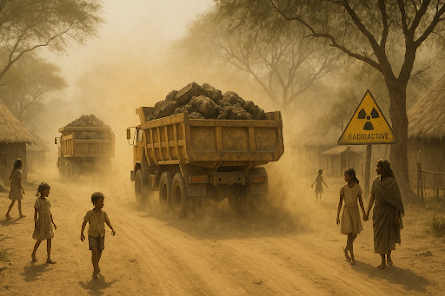🛑 Disclaimer
Heads up! This post is a departure from my usual tone—it’s heavier, more serious, and deeply personal. We're diving into real voices, harsh data, and urgent calls to action. If you're ready for some uncomfortable truths, read on.

“They took away my land …but gifted me cancer.” — Agnu Murmu, 35, Jadugoda villager
That haunting line shakes you. Jadugora, once a tribal haven, now bears the scars of India’s nuclear ambition. Under lush hills lie uranium mines—operational since 1967—managed by the Uranium Corporation of India Limited (UCIL). They promised schools, hospitals, livelihoods. What they left behind? Radioactive dust, genetic deformities, cancer, miscarriages, and desperate hope.
This isn’t fiction. This is lived reality for tens of thousands of Adivasi families. Let’s unpack how nuclear mining turned a once-thriving hamlet into a living graveyard.
📍 1. Where Is Jadugora?
-
Located in East Singhbhum, Jharkhand—about 30 km from Jamshedpur
-
First uranium mine in India began in 1967 in Jaduguda, later expanding to Narwapahar, Turamdih, Bhatin
-
Approximately 35,000–50,000 people live within a 5 km radius of tailing ponds
Scenic landscapes hide a deadly secret: unlined tailing ponds, uncovered radioactive dust, and uranium-laced water.
⚛️ 2. The Pollution Pipeline & Exposure Paths

-
Mining + milling = uranium ore crushed + chemically treated → tailings retaining ~75–80% radioactivity
-
Danger points:
-
Tailings ponds near villages → dust blows in dry season; leaks contaminate water during monsoons
-
Uranium dust from trucks → roads, fields → breathed, eaten, absorbed
-
Miners provided only one uniform/week → contaminates home, water, washing areas
-
Studies found gamma radiation levels as high as 10 mSv/year near tailings (WHO safe limit ~1 mSv) Nuclear Risk. Even without total figures, we know people are being irradiated—daily.
🧬 3. Illnesses, Miscarriages & Mutations
🔹 Congenital deformities & child mortality
-
Study: 1.84× increase in congenital deformities; deaths due to deformity ~9.3% in affected villages vs. 1.7% in controls.
-
Independent surveys: ~9 children died before age 1 in UCIL villages (8 from deformity) vs. 6 in control villages.
-
Photo reports document children born with cerebral palsy, tumors, limb deformities
-
People like Babloo (7) in wheelchairs since birth.
🔹 Miscarriages & infertility
-
Tata Institute study (1998–2003): 18% of women endured miscarriages/stillbirth; 30% fertility issues.
-
Other study: Couples 1.58× more infertility, 1.84× more deformities. 30,000 affected across 15 villages.
🔹 Cancer, respiratory & blood disorders
-
Cancer deaths: 2.87% of UCIL-area families vs. 1.89% controls.
-
Tumors, leukemia, renal disease documented.
-
Lung disease, silicosis-like ailments in miners.
-
Thalassemia, skin disorders, neuro disorders also reported
Life expectancy drops: 68% died before state mean of 62 years.
😔 4. Social Suffering, Stigma & Neglect
-
Women called “baanjh” (sterile), abandoned, shunned.
Children with deformities socially outcast.
-
Villagers losing traditional livelihoods—bidis, collecting tendu leaves spoiled by polluted soil/water.
-
Loss of sacred forests, ancestral land, spiritual roots.

👎 5. Government & UCIL Response: Denial & Deflection
-
UCIL & BARC (1998) said diseases from malnutrition, malaria, alcohol—not radiation; no real studies done.
Year 2006 tailings spill triggered judicial inquiry—but no transparency or action.
-
Official position: “Radiation within permissible limits”—yet data is classified.
-
Workers receive scant protective gear; largely contractual labor paid ~₹300/day.
🔬 6. Independent Research: Evidence Speaks Louder
-
Japanese Kyoto University: gamma radiation up to 10 mSv/year.
-
Indian Doctors for Peace & Development (2007): doubled congenital deformities, fertility issues, cancer deaths in UCIL area.
-
Sanghmitra Gadekar (surveyed 9,000 villagers): documented deformities, miscarriages, cancer, lung illnesses.
-
Tata Institute: miscarriage/stillbirth stats.
🤯 7. Human Stories: Faces of Tragedy
-
Agnu Murmu: Died of cancer; family lived by tailings pond.
-
Jingi Birulee: Born with conjoined fingers; stigmatized as barren.
-
Babloo & Anamika Oraom: Cerebral palsy, facial tumors; families without treatment access.
-
Parvati & Kartik Gope: Muscle degeneration, seizures, scoliosis.
These aren’t just statistics—they are mothers, fathers, sisters, brothers—our neighbours paying a heavy, silent price.
🧪 8. Environmental & Economic Losses
-
Land seized for tailings ponds; contaminates groundwater & rivers
-
Economic collapse: farmers can’t grow; traditional livelihoods gone.
-
Cultural uprooting: loss of jaherthans (sacred groves), tribal rituals

✊ 9. Tribal Resistance & Demand for Justice
-
Jharkhandi Organisation Against Radiation (JOAR) led by Ghanshyam Birulee fights for:
-
Independent health audits
-
Better compensation
-
Relocation of villagers
-
Closure of unsafe tailings.
-
-
Protesters harassed, arrested (e.g., JOAR activists in 2014).
-
Documentary "Tailing Pond" (nominated for Oscar) amplifies victims' stories.
📢 10. Why It Matters for All of India
-
India plans more nuclear power—but at what cost?
-
Lack of environmental justice, transparency, community consent
-
Health harm could spread beyond villages to Jamshedpur upstream.
-
Global lessons: how nations must balance nuclear energy with ethical obligations
🛠️ 11. What Must Be Done Now
-
Independent health impact study by trusted institutions
-
Public release of radiation/water/soil data
-
Tailing pond safeguards: re-lining, fencing, relocation of villages ≥3 km.
-
Adequate healthcare & compensation including for chronic and genetic illness
-
Community engagement: informed consent and tribal rights
-
Strict regulation & oversight by environmental and atomic boards
🧭 12. Final Takeaway: Who Are We If Lives Are Bought for Power?
Jadugora isn't just a local tragedy; it's a case study in moral failure—where development tramples human dignity. The uranium-paved roads leading to nuclear reactors should not pave over the human cost endured in remote tribal lands.
If you care about justice, health, tribal rights, or even sustainable energy, the story of Jadugora demands your attention.
✅ Call to Action
-
Share this post widely
-
Tag journalists, activists, NGOs
-
Pressure lawmakers for transparency and accountability
-
Advocate for justice so Jadugora isn’t forgotten
Let’s be the voice for those whose voice has been buried under radioactive dust.
Comments
Post a Comment